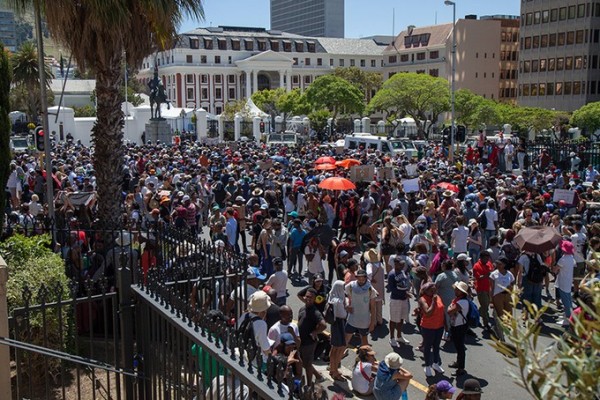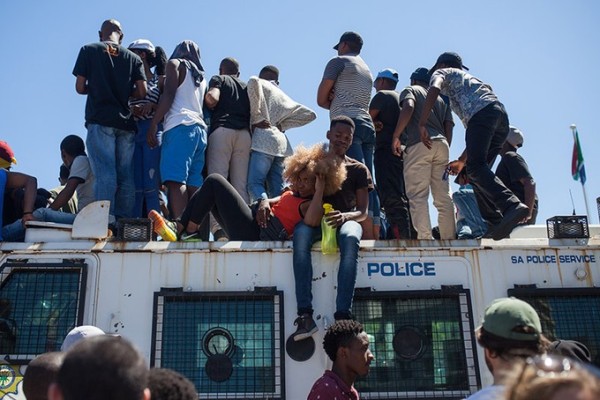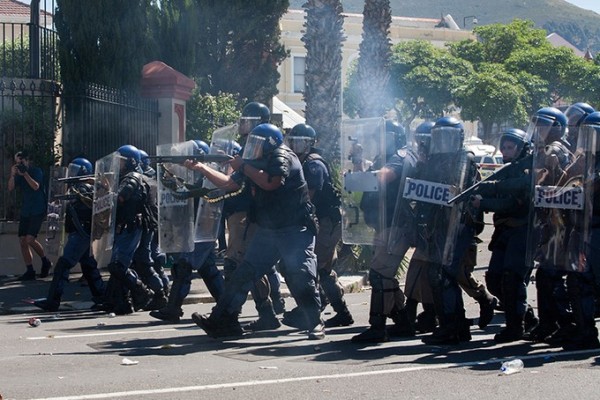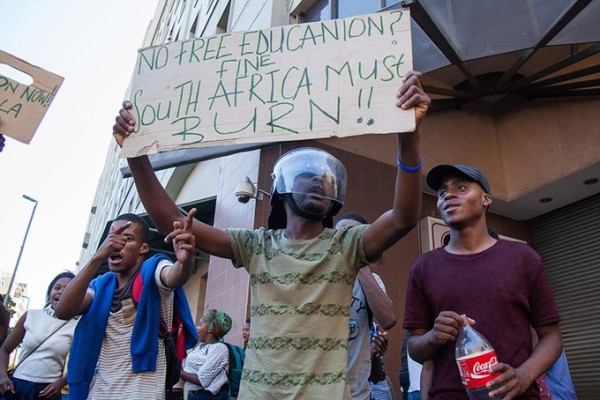Outside Parliament

Picture: Poloho Selebano
I arrive at beginning of the #feesmustfall march on CPUT’s Cape Town campus a little before 12. I’ve Uber-ed here, deciding to leave my car in the Gardens Shopping Centre not far from where the march will end. A good decision, as traffic is already disrupted, with hippos and other police vehicles lining the street up and down the Keizergracht. It’s the hottest day of the spring so far, with a blazing hot sun and no wind. Perfect marching weather!
The march has been called by the Cape Peninsula Technicon, but it has swelled to include a number of different groups, including #feesmustfall students from UWC and workers campaigning for an end to outsourcing. The plan is to proceed to Parliament, where our embattled Minister of Finance is about to present his mid-term expenditure framework, and to present him with a memorandum of student’s concerns. After the fractious days of the last few weeks, and the fears of polarization on our own campus, this has seemed to me and many of my colleagues to be an important opportunity for trying to build bridges. If the struggle around student fees continues to be framed as an adversarial struggle between students on the one side and university management on the other, we’re all in trouble. The ability of this movement to lead to positive change depends, or so it seems to us, on our ability to construct a broader alliance of students, staff and University management around (among other things) the need for better funding for tertiary education.
I have been particularly concerned by a dangerous dynamic unfolding on campuses. Now, as during last year’s protests, a prominent role has been played by groups of angry young people indulging in reckless, even violent acts. Alongside open, inclusive, ‘intersectional’ approaches there have also been chauvinistic and coercive ones. How these different aspects of the students movement relate, and how they will work out, I don’t completely understand. But it seems to me that these tendencies are exacerbated when students feel alone and unsupported. If they feel less isolated – if they know that teachers and other staff on campus support their broad demand for more accessible, more relevant education, or are simply there in sympathy – this may prevent the destructive dynamic of increasing conflict. So this seems to be an important moment. At UWC, FMF students rather peremptorily instructed our University management to join them. University management (unfortunately, in my view) declined. And though that is a disappointment and (I think) a lost opportunity, I’ve decided to come in my own capacity and be part of this thing.
CPUT is alive with young folk – I am not good at estimating numbers, but it looks like upward of three thousand people, scattered on the grass and on the terraces behind the admin building. The event has that sense of organized chaos so typical of large, free-flow crowd events. Peace monitors are everywhere in evidence. There is also a visible presence of marshals. At the same time it’s a situation where it’s going to be very easy to lose track of any friend or colleague you want to meet. Calling people on phones is useless, as the noise levels are too high; and I’ve already met two people whose smartphones have simply shut down because of overheating. High-latitude technology. But soon enough I bump into some UWC colleagues. I’m told that as academics, we have been asked to ‘join the clergymen.’ This is not a thing I’d do instinctively – I’m more one of your rootless, secular cosmopolitans – but today my intention is to do what I can to help make this thing work. Eventually I find someone who looks like a clergyman (male, frock, white dog-collar, seems legit) and stick to him.
The mood is ebullient and festive. Someone with a loudspeaker in the centre of the crowd is briskly addressing us all, enjoining us all to be disciplined and to not harass other marchers. I am glad to hear this, given that there has been talk of disrupting the DASO march also taking place today. Very little in the way of overtly political signage, though EFF’s red and PASMA’s green is everywhere in evidence. Most signs are hand lettered and improvised. The biggest one I can see calls for ‘Free Education or Death,’ which frankly sounds like a bad idea. Someone else has a big crucifix. There is also a small cardboard coffin tossing like a little ship on the heads and shoulders of the crowd, bearing a picture of Education Minister Blade Nzimande.

Picture: Ashraf Hendricks, Groundup
Then we’re off. A little early, according to my watch, and surprisingly quickly. At the beginning it’s more a jog than a march, and pretty soon I’ve lost touch with my clergyman. No matter, since I have made contact with friends, students and colleagues, and also with my sister Marijke. She’s there with her own neatly printed sign saying ‘Siyavelana nabafundi bethu’ – we hear / feel our students. (Mine says, rather unimaginatively ‘Education for Liberation.’ ) A group of colleagues have transliterated Marijke’s slogan onto a long cloth banner and are endeavouring to walk in line carrying it at the front of the march. For a while I try to join them in this enterprise, but there is simply too much jostling and after a while I fall back from the frontline, moving with the crowd.
In all of this the festive, jovial, playful mood of the young people is evident. The crowd is diverse, composed mostly of CPUT students; all full of the joys of spring. There is much improvisatory playing with protest songs, greatly enjoyed even by those who do not (or, like me, are unable to) take part. None of my generations’s lugubrious Senzeni Na for this crowd; the songs are snappy, cheerful, brimming with energy. Early on in the march, we are suddenly pelted by light little pink packets. These seem to contain face masks. For teargas, someone explains. More pink packets shower us from a different direction. Condoms. (Apparently the lubricant provides relief against teargas. One lives and learns).
Police are monitoring us closely. Initially there are some attempts on the part of the police to get us to march in an orderly fashion with marshals in front but this proves futile. Fortunately, this does not spill over into violence: marchers, peacekeepers and police all seem to agree that the thing to do now is to get to Parliament as smoothly and pleasantly as possible. We move fairly chaotically but still smoothly and rapidly up Keizergracht, past the parade, and up Buitenkant.
Passersby and onlookers seem irritated (especially those who are sitting in cars, mired in a traffic jam while the students flow around and past them). Others seem to approve and wave or applaud students from balconies. A lean and wiry fellow with a big Afro leans out of a high window and makes a black power salute, which gets an appreciative response. Roadside vendors prudently shutter their stalls. What strikes me is the multitude of scripts already in play. For us in the march, this is a jovial performative occasion, a moment to be seen and to be heard; for those in the cars and in the shops, we are an irritation and possibly even a threat.
Surprisingly quickly, we arrive at Parliament. The van of the crowd collects at the Stalplein, by that bombastic statue of Louis Botha on his horse. The crowd is large and fills up all of the last street block of Roeland. I suppose now is the time to go seek out my clergyman, but it’s a hot hot day, the crowd is jam packed and we’re probably in for a long wait. I head over to the other side of the street, where St Mary’s Cathedral and its adjoining palm trees promise some shade.

Photo: Ashraf Hendricks, Groundup
And there we wait. It’s not even 1 PM, (the march by which the march was supposed to start), so it’s a long wait. More a people arrive. The singing continues, with increasingly baroque variations. An enterprising couple of young white guys with the sporty, relaxed look of surfers walk back and forth between Roeland Street and the Stag’s head, carrying large plastic containers of water. The more forward-thinking people in the crowd bring out umbrellas to protect them from the sun. A helicopter appears and starts circling ominously, clattering by alarmingly close to the local high-rise buildings. Other than that, the mood is relaxed and calm. Those who are not singing get out their phones; start posing for selfies and checking their feeds.
I do the same: not for selfies, but for my WhatsApp thread and Twitter. Some journalist reports that Pravin Gordhan has indeed come out of parliament to meet with the marchers. Good man. Pravin is the man of the moment in South Africa, a solid little point of stability in a sea of venal bunglers. He seems to have made sympathetic remarks, telling the students he’s been in their position too. Later on, more tweets convey nuggets from his speech inside parliament; again, he takes a noticeably sympathetic stance. An encouraging sign, I think.
Time passes, and it’s not clear what happens now. Do we march back to CPUT? Or just wait for the 3PM curfew to roll around? What happens then? I connect up with two colleagues from PLAAS; we share office talk and thoughts about current events. People start drifting off. I am feeling tired and hungry. I get a message from my partner; my stepdaughter Ruby is sick and needs to be taken to a doctor. I say my goodbyes and leave Roeland Street.
Later in the day, I monitor things on Twitter and on our collegial WhatsApp thread. All seems well. Someone posts a lovely picture on Twitter of of a group of students sitting on a police nyala in the heat of the day, completely casual and at peace alongside the police. An image of a moment of harmony.

Picture: Ashraf Hendricks, Groundup
Meanwhile, Gordhan is making constructive gestures inside Parliament, promising R 17 billion more for tertiary education. Some journalists notice Zuma nodding off. Others report that Zuma’s cronies are looking bored and distracted, checking their phones. Maybe they’ve got other fish to fry, I think, than what happens in Parliament.
Then at 3 PM sharp, a colleague posts on WhatsApp. The fucking cops, she says, have just let rip with stun grenades and rubber bullets. What’s going on? “Fucking mayhem”, offers one colleague. “Fucking chaos”, says another. Someone reports “Rubber bullets down the side streets.” There was no warning, my colleagues say. The police just started shooting. There was no order to disperse.

Picture: Ashraf Hendricks, Groundup
Oy vey. Audio clips get shared: scary snatches of gunfire sounds, screaming, angry shouting. Images of students running, throwing stones, of clouds of tear gas, of spent cartridges lying on the road. Stories also filter in on Twitter. Pictures of discarded shoes and broken or crushed sunglasses. What’s going on? eNCA reporters are posting clips on line, but they seem to be caught in a different reality, with a rattled Annika Larsen reporting the event as if the students had been the aggressors, and describing the march as ‘a standoff’ with students (why a standoff? They presented a memorandum and it was accepted by Pravin!). Other news organisations report that ‘parliament is under lockdown.’

Photo: Annika Larsen
From there things go the way they always go at such events: mayhem, injuries, running battles in the streets. Students threw stones at plate glass windows. Other students shouted at them to stop. A student got hit in the head by a brick thrown by another student. The violence spread down Buitenkant and onto the Parade. People stoned a bus and looted a Truworths store in Adderley street. Meanwhile, various eyewitness accounts by colleagues and strangers have the police moving up Roeland and its side streets, shooting indiscriminately at anything that moved.
Groundup estimates that the students involved in violence did not number more than 100.
I don’t have more valid insights into what happened here than anyone else who took part. I was far from the front lines, and I was not even there when the violence broke out. But I do have two observations:
First, it’s worth reflecting on how the violence started: One theory is that as the protest neared its rather anticlimactic end,and has students got rowdier and more restive, the coffin bearers decided to set fire to their coffin and throw it over the police line. This seems to have been the trigger that set everything off. You can see footage of this act online. To my eyes the coffin looks small and shabby; a little battered after its long passage up Roeland Street. A small knot of fire roils fiercely at its centre. There are angry shouts; things already look badly out of hand. The marchers surge forward and lunge towards the line of police officers standing behind their perspex shields. The coffin flies straight over the police line and falls harmlessly on the ground behind them. As a piece of protest theatre it is to my mind rather unimpressive. But as a moment around which the march could pivot into violence it is decisive. The police react instantly, letting off a barrage of rubber bullets and teargas, and within three seconds the whole street has slid into a chaos.
Later, posts do the round on Twitter, saying the cops had no choice, the students had thrown ‘a burning coffin’ at them; a depiction sounding far more dangerous and exciting than the prosaic reality.
Other accounts say that the police moved the Nyala with students on the roof and braked suddenly so that a student fell off; there are even allegations that the Nyala almost drove over the student who had fallen. On the video these actions appear either dangerously careless or quite deliberate. This may have been the event that triggered the coffin-throwing. As usually, there are a mass of sometimes corroborating, sometimes conflicting accounts. Fog of war.
Perhaps poor planning had something to do with it. As one colleague later remarked, in the old UDF days you would have made sure that there was also a leadership who could lead the march away from Parliament in time for the 3 PM curfew. Certainly many accounts of the last moments of the march indicate that groups of students were getting rowdy and defiant.
It is also clear that at this march, as on campuses all over the country, there were people – some students, some perhaps not – who did want some sort of violent confrontation. But during the time I was there they were far from setting the tone. On this particular day, it seems to have been the overreaction of the police that provided the tipping point and opened the doors to the script of violence. In my opinion any public order police worth their salt could have de-escalated the coffin-throw. A hand -sized fire extinguisher could have done the trick. With some fast and canny thinking, and co-operation with the leadership of the march, it should have been possible to end the day peacefully. But this did not happen. Instead, the police seem to have treated the coffin incident as the trigger that gave them permission to use force, and then used means of dispersal almost guaranteed to tip the day over the edge into violence.
Secondly, and in a way much more importantly, what strikes me most of all is what happened within a few short moments to the framing of the incident.
A day that initially developed as a certain kind of public democratic performance (a peaceful march, improvisation with protest songs, a meeting with a Minister, a speech in Parliament) was in a space of ten minutes transformed into a narrative of conflict, violence and securitisation. Students running amok. Stones heaved through plate glass windows. Passers-by assaulted. “Parliament under lockdown”.
The essentially good natured tone of most of the march, and the essentially serious and earnest response from the Finance Minister: these disappeared within moments, replaced by the aftertaste of teargas and burning rubbish in the streets; by anger at violent police and irresponsible students.
Who is served by this? It does not serve the students, or their cause. It does not serve the universities and technicons. It does not serve the Minister of Finance, and definitely not Parliament.
It serves those who co-conspire to create violence. It serves those for whom public disorder has its own rewards. It serves the chauvinistic agenda of groups like Black First Land First, whose members have in the past called for ‘fire’ to be brought to our Universities. It also serves those still defending white privilege, who prefer to see the students simply as thugs and hooligans. It serves the securocrats, and those (including those in our Cabinet) who believe that forceful repression is what is needed to make the problems go away.
It closes off, from the left and the right, the opportunities that still exist to create a meaningful and transformative politics on the basis of our students’ movement.
This is what is happening to our democracy.

Photo: Ashraf Hendricks, Groundup

I really appreciate the nuance of this account. Once again, the subtlety of your posts is refreshing.